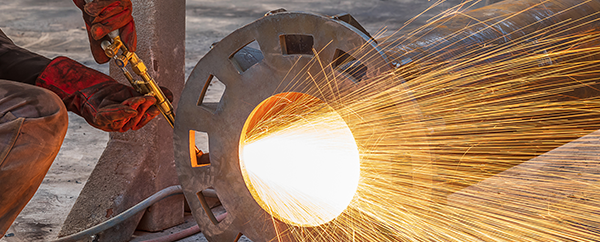
Your hearing: Protect it or lose it
Fireworks. Rock concerts. Headphones turned up full volume. All contribute significantly to hearing loss, but they’re also easily preventable. You simply choose not to be near them or use them.
But what about hearing loss on the job from loud noises, like a drill, jackhammer or forklift for construction or warehouse workers, a garbage truck or farm equipment – or a lawnmower and leaf blower? All can cause hearing damage. If your tribal entity uses any of this equipment, it’s important to help your workers protect their hearing.
How loud is too loud?
At 85 decibels (dBA), which is about the noise level of city traffic, damage occurs after eight hours of exposure. But at 91 dBA, noise results in damage after only two hours.
Sound only becomes physically painful at about 125 dBA, so it is easy to exceed the 85-dBA threshold without realizing it. The longer your unprotected ears are exposed to a dangerous level of sound, the worse the damage to your eardrums—and your hearing, says EHS Daily Advisor.
Even without a device to measure sound, you can typically tell if the noise around you is too loud. If you or others need to shout to be heard or cannot understand each other even at arm’s length away, the sound is too loud and may damage your hearing over time.
The Center for Disease Control (CDC) estimates that 22 million workers are exposed to potential hearing loss on the job each year. Whether you work at a sports venue, on a tarmac, or operate a jackhammer—hearing loss is preventable.
EHS Daily Advisor lists a few occupations where sound levels are potentially dangerous. Some of these may surprise you:
- Groundskeepers: 82-102 dBA (both a lawnmower and leaf blower are 90-100 dBA)
- Music teachers: 84-91 dBA
- Farmers: 85-90 dBA
- Sanitation workers: 85-100 dBA
- Orchestra musicians: 95 dBA for brass sections, up to 130 dBA for peak percussion
- Ambulance drivers or EMTs: 110-140 dBA
- Air traffic controllers: 110-140 dBA from jet engines
- Construction workers: 85-100 dBA from jackhammers
- Warehouse workers: a forklift is 96 dBA
Noise may be a problem in your workplace, says OSHA, if you:
- Hear ringing or humming in your ears when you leave work.
- Must shout to be heard by a coworker an arm’s length away.
- Experience temporary hearing loss when leaving work.
Exposure to loud noise kills the nerve endings in our inner ear. More exposure will result in more dead nerve endings. The result is permanent hearing loss that cannot be corrected through surgery or with medicine. Noise-induced hearing loss limits your ability to hear high frequency sounds and understand speech, which seriously impairs your ability to communicate. Hearing aids may help, but they do not restore your hearing to normal.
Related: A workplace safety incentive program helps stop accidents before they start

How can noise be controlled in the workplace, to prevent hearing loss on the job?
As a guideline for tribal entities, OSHA requires employers to implement a hearing conservation program when noise exposure is at or above 85 decibels averaged over 8 working hours, or an 8-hour time-weighted average (TWA). Hearing conservation programs strive to prevent initial occupational hearing loss, preserve and protect remaining hearing, and equip workers with the knowledge and hearing protection devices necessary to safeguard themselves.
Engineering controls
One option for hearing conservation is to employ engineering controls such safety glass or sound-absorbing materials. Engineering controls involve modifying or replacing equipment, or making related physical changes at the noise source or along the transmission path to reduce the noise level and prevent hearing loss on the job.
OSHA lists examples of inexpensive, effective engineering controls include some of the following:
- Choose low-noise tools and machinery (e.g., Buy Quiet Roadmap).
- Maintain and lubricate machinery and equipment (e.g., oil bearings).
- Place a barrier between the noise source and employee (e.g., sound walls or curtains).
- Enclose or isolate the noise source.

Administrative controls
These controls are changes in the workplace that reduce or eliminate the worker exposure to noise, such as:
- Operating noisy machines during shifts when fewer people are exposed.
- Limiting the time a person spends at a noise source.
- Providing quiet areas that provide relief to workers from hazardous noise sources (e.g., construct a sound proof room where workers’ hearing can recover – depending upon their individual noise level and duration of exposure, and time spent in the quiet area).
- Restricting worker presence to a suitable distance away from noisy equipment.
Controlling noise exposure through distance is often an effective, yet simple and inexpensive administrative control. This control may be applicable when workers are present but are not actually working with a noise source or equipment. Increasing the distance between the noise source and the worker, reduces their exposure that would result from hearing loss on the job. In open space, for every doubling of the distance between the source of noise and the worker, the noise is decreased by 6 dBA.
Providing hearing protection
Hearing protection devices (HPDs), such as earmuffs and plugs, are considered an acceptable but less desirable option to control exposures to noise. They’re generally used during the time necessary to implement engineering or administrative controls, when such controls are not feasible, or when worker’s hearing tests indicate significant hearing damage. CDC offers additional information on hearing protecting devices.
Related: Beyond face masks: Workplace Personal Protective Equipment

Implementing a hearing conservation program
Whenever worker noise exposure is equal to or greater than 85 dBA for an 8 hour exposure, a hearing conservation program is strongly advised. In the construction industry when exposures exceed 90 dBA for an 8 hour exposure, a conservation program is also crucial. This program strives to prevent initial occupational hearing loss, preserve and protect remaining hearing, and equip workers with the knowledge and hearing protection devices necessary to protect them.
OSHA provides these key elements to your hearing conservation program:
- Workplace noise sampling including personal noise monitoring to identify employees at risk from hazardous noise levels.
- Informing workers at risk from hazardous noise levels the results of their noise monitoring.
- Providing affected workers or their authorized representatives with an opportunity to observe any noise measurements conducted.
- Maintaining a worker audiometric testing program (hearing tests): a professional evaluation of the health effects of noise upon individual worker’s hearing.
- Implementing comprehensive hearing protection follow-up procedures for workers who show a loss of hearing (standard threshold shift) after completing baseline (first) and yearly audiometric testing.
- Proper selection of hearing protection based upon individual fit and manufacturer’s quality testing indicating the likely protection that they will provide to a properly trained wearer.
- Evaluate the hearing protectors attenuation and effectiveness for the specific workplace noise.
- Training that ensures the workers are aware of the hazard from excessive noise exposures and how to properly use the protective equipment that has been provided. This interactive infographic from CDC is a great tool to use in your training meetings.
- Data management of and worker access to records regarding monitoring and noise sampling.
Related: Creating an effective employee education plan
Commercial noise monitoring equipment is available, but there are some good noise-level apps available these days for smartphones, such as HearingAtWork.org or NIOSH’s sound level meter. One caveat: your smartphone app must be calibrated to ensure that the readings are accurate.
Hearing loss is permanent – but preventable with these safety steps listed above. It’s an injury that’s not necessarily felt, but still results in a permanent loss. We urge you to take steps to prevent hearing loss on the job right away.
